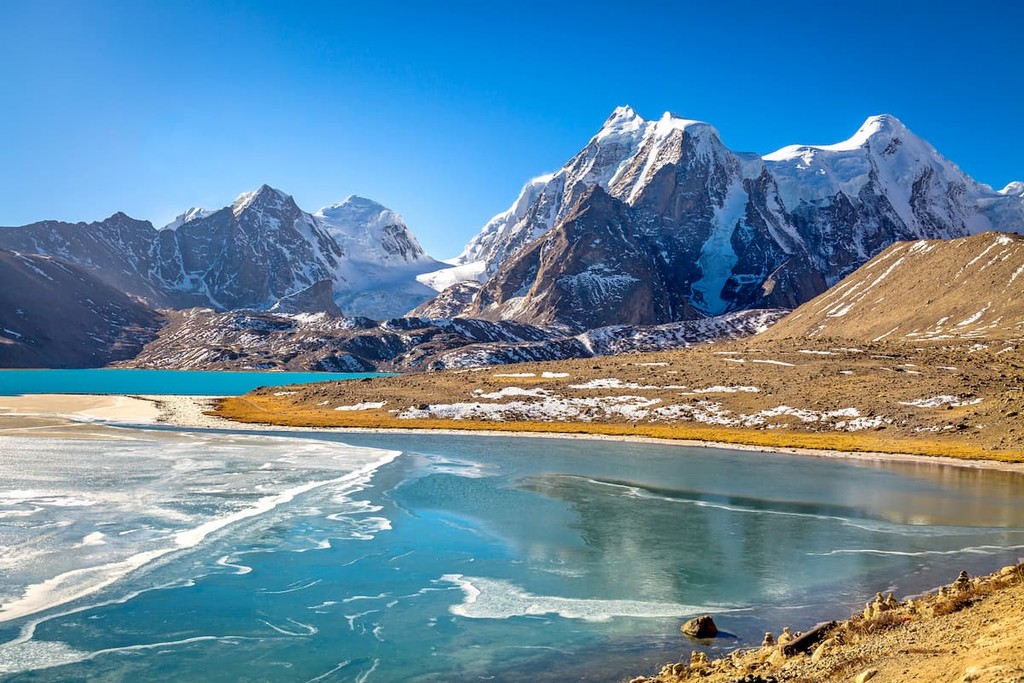
Art Integration Project On Sikkim For Class 11
Acknowledgment:
I would like to express my sincere gratitude and appreciation to all those who have contributed to the successful completion of my Art Integration Project on Sikkim. Their support and encouragement have been invaluable throughout this journey.
I am deeply grateful to my art teacher, [Teacher’s Name], for providing me with the guidance and inspiration to explore the rich artistic heritage of Sikkim. Their expertise and encouragement have been instrumental in shaping my artistic expression.
I would also like to extend my thanks to my parents for their constant encouragement and understanding. Their unwavering support has been a constant source of motivation.
Furthermore, I am indebted to the library staff and online resources that have provided me with a wealth of information about Sikkim’s culture, art forms, and traditions. Their resources have been immensely helpful in enriching my understanding of the subject.
Last but not least, I want to acknowledge the people of Sikkim who have preserved and cherished their cultural heritage, making it a truly remarkable and inspiring place to explore through art.
Thank you, once again, to everyone who has contributed to this project. Your support has made this journey rewarding and fulfilling.
Introduction to Sikkim:
Nestled in the eastern Himalayas, Sikkim is a mesmerizing and picturesque state in northeastern India. Known for its enchanting landscapes, diverse cultures, and warm hospitality, Sikkim has earned the nickname “The Land of Mystical Splendor. ” Despite being the smallest state in India, it is abundant in natural beauty and cultural heritage, making it a popular destination for travelers seeking tranquility and adventure.
- Geography and Location:Sikkim shares its borders with three neighboring countries – Nepal to the west, Tibet (China) to the north and east, and Bhutan to the southeast. It is strategically situated along the ancient Silk Route, which facilitated significant cultural exchanges between India and Tibet.
- Capital and Major Cities:The capital city of Sikkim is Gangtok, perched on a ridge at an elevation of approximately 1, 650 meters (5, 410 feet) above sea level. Gangtok serves as the administrative, cultural, and commercial hub of the state. Other notable towns and cities include Namchi, Pelling, Yuksom, and Lachen, each offering its own unique charm.
- Cultural Diversity:Sikkim boasts a remarkable cultural diversity with a blend of various ethnic groups. The three main communities are:
- Lepchas: The original inhabitants of Sikkim, the Lepchas, have a distinct culture deeply connected to nature and the mountains. Their traditional attire, language, and unique customs showcase their rich heritage.
- Bhutias: Influenced by Tibetan culture, the Bhutias are known for their vibrant festivals, ornate monasteries, and colorful attire. Buddhism plays a significant role in their lives.
- Nepalis: The Nepali community forms a significant portion of Sikkim’s population. They contribute to the state’s cultural mosaic with their traditions, language (Nepali), and festivals.
- Religion and Spirituality:Sikkim is a melting pot of religions, with Buddhism and Hinduism being the predominant ones. The state is adorned with numerous Buddhist monasteries or “Gompas, ” many of which are perched on hilltops, exuding a sense of serenity and spirituality.
- Tourism and Biodiversity:Sikkim’s breathtaking natural beauty attracts tourists from around the world. The snow-capped peaks of Kanchenjunga, the third-highest mountain in the world, dominate the skyline. Lush green valleys, alpine forests, cascading waterfalls, and tranquil lakes contribute to the state’s unmatched charm.
- Conservation and Sustainability:Sikkim takes pride in its commitment to environmental conservation. In 2016, it became India’s first fully organic state, focusing on sustainable agricultural practices and minimizing the use of synthetic pesticides and fertilizers.
- Adventure and Trekking:For adventure enthusiasts, Sikkim offers a plethora of opportunities, including trekking trails that lead to awe-inspiring viewpoints and serene alpine lakes. Popular treks include the Goecha La Trek, Singalila Ridge Trek, and Dzongri Trek.
- Conclusion:Sikkim’s allure lies not only in its natural splendor but also in the harmonious coexistence of its diverse cultures. It remains a treasure trove for those seeking an escape into the lap of nature and an enriching cultural experience that resonates with the essence of the Himalayas.
Cultural Diversity in Sikkim:
Sikkim’s cultural diversity is a unique tapestry woven from the traditions, customs, and beliefs of various ethnic communities that call this enchanting state their home. Each group contributes its own vibrant hues to the cultural landscape, creating a harmonious coexistence that makes Sikkim a fascinating and inclusive destination. Let’s explore the major aspects of cultural diversity in Sikkim:
- Lepchas:
The Lepchas, also known as the Rong, are the original inhabitants of Sikkim. They have a distinct cultural heritage deeply rooted in their close connection with nature.
Traditionally, the Lepchas practiced animism, worshiping spirits of mountains, forests, and rivers. However, many Lepchas have embraced Buddhism and Christianity in recent times.
Their traditional attire includes colorful dresses like “Dhutu” for men and “Monyul” for women, adorned with intricate embroidery and handmade jewelry.
- Bhutias:
The Bhutias are of Tibetan origin and migrated to Sikkim several centuries ago. They have significantly influenced the cultural and religious landscape of the state.
Buddhism is a central aspect of Bhutia culture, and many Bhutias actively participate in religious practices and rituals at the numerous monasteries and Gompas scattered across the region.
“Dumpling” or “Momos” is a popular Bhutia culinary delicacy that has become an integral part of Sikkimese cuisine.
- Nepalis:
Nepalis form a significant part of Sikkim’s population and play an essential role in the state’s economic, social, and political life.
The Nepali community brings its rich cultural traditions, music, and dance to Sikkim. Festivals like Dashain, Tihar, and Holi are widely celebrated among the Nepali population.
The Nepali language (Nepali or Gorkhali) is widely spoken and serves as the lingua franca of the state.
- Festivals and Celebrations:
Sikkim is a land of festivals, with each community celebrating its own unique set of events. Some of the prominent festivals include Losar (Tibetan New Year), Saga Dawa (celebrating Buddha’s life), and Maghe Sankranti (Nepali harvest festival).
During festivals, traditional music, dance, and elaborate masked performances are staged to commemorate religious and cultural occasions.
- Art and Handicrafts:
Sikkim’s cultural diversity is beautifully reflected in its art and handicrafts. The Thangka paintings, intricate carpets, wooden carvings, and bamboo products all showcase the rich artistic heritage of the state.
Skilled artisans and craftsmen, often belonging to specific communities, meticulously create these artworks, preserving age-old techniques passed down through generations.
- Religious Harmony:
Sikkim stands as a shining example of religious harmony, with people of different faiths coexisting peacefully. Buddhists, Hindus, Christians, and practitioners of indigenous beliefs share mutual respect and understanding.
- Music and Dance:
Traditional music and dance are integral to Sikkim’s cultural expression. Each community has its own repertoire of folk songs and dance forms that reflect their history, beliefs, and way of life.
The vibrant and rhythmic performances during festivals and social gatherings create a joyous atmosphere that brings people together.
Overall, Sikkim’s cultural diversity is a testament to the state’s inclusive and welcoming spirit. The convergence of various traditions and customs in this picturesque land adds depth and color to the social fabric, making it a treasure trove of cultural exploration for visitors and residents alike.

Performing Art:
- Performing Arts in Sikkim
Sikkim is a hub of vibrant performing arts that showcase the rich cultural heritage and traditions of its diverse communities. The performing arts in Sikkim encompass various dance forms, music, and theatrical performances. These art forms are not only a means of entertainment but also hold significant religious, social, and cultural importance. Let’s explore some of the prominent performing arts in Sikkim:
- Folk Dances:
Maruni: Maruni is a popular folk dance performed primarily by the Nepali community during festivals like Dashain and Tihar. Dancers, clad in colorful traditional attire, gracefully move to rhythmic tunes, often depicting stories of love and social themes.
Tamang Selo: This lively folk dance form is performed by the Tamang community. It involves rhythmic footwork, hand clapping, and traditional musical instruments like damphu (a percussion instrument) and flute.
Gha To Kito: This dance form is characteristic of the Bhutia community and is often performed during the Losar festival (Tibetan New Year). Dancers, dressed in elaborate costumes, perform intricate steps while holding colorful prayer scarves.
- Mask Dance (Cham Dance):
Cham dance is an integral part of religious festivals in Sikkim, especially in Buddhist monasteries and Gompas. Dancers wear vibrant and intricate masks representing various deities and perform ritualistic dances, often accompanied by traditional music and chanting.
- Music:
Music plays a significant role in Sikkim’s cultural expression. Traditional musical instruments like damphu (drum), flute, cymbals, and traditional string instruments add charm to the performances.
The melodious tunes of folk songs and religious hymns can be heard during festivals and celebrations, reflecting the state’s spiritual and festive spirit.
- Theatre:
Theatre and dramatic performances are gaining popularity in Sikkim, especially in urban centers like Gangtok. Local theatre groups often stage plays that address social issues, cultural themes, and contemporary topics.
- Modern Dance and Music:
Sikkim’s performing arts scene also embraces modern dance forms and contemporary music. Young artists and performers often blend traditional elements with modern influences, creating innovative and engaging performances.
- Festivals and Cultural Events:
Sikkim’s festivals are occasions when the performing arts take center stage. During Losar, Saga Dawa, and other religious festivals, the state comes alive with colorful processions, dances, and music performances.
- Preservation and Promotion:
The government and various cultural organizations in Sikkim actively promote and preserve the traditional performing arts of the state. Cultural festivals and competitions are organized to encourage the younger generation to participate and carry forward these art forms.
Conclusion:
The performing arts in Sikkim are a reflection of the state’s vibrant cultural diversity and a celebration of its age-old traditions. These artistic expressions not only entertain but also serve to connect people to their roots, heritage, and spirituality. Whether it’s the rhythmic beats of folk dances or the soul-stirring chants of religious ceremonies, the performing arts of Sikkim hold a special place in the hearts of both performers and audiences alike.
Conservation Efforts:
Conservation Efforts in Sikkim
Sikkim has been at the forefront of environmental conservation and sustainable development in India. The state’s government, along with various organizations and communities, has taken significant steps to protect its unique biodiversity, natural resources, and cultural heritage. Here are some of the notable conservation efforts in Sikkim:
- Organic Farming:
In 2016, Sikkim achieved the remarkable feat of becoming India’s first fully organic state. The state banned the use of chemical fertilizers and pesticides in agricultural practices.
Organic farming not only helps preserve the soil fertility and biodiversity but also promotes healthier produce for both locals and visitors.
- Conservation of Biodiversity:
Sikkim is rich in biodiversity, with a wide range of flora and fauna endemic to the region. The state has established several national parks and wildlife sanctuaries to protect its diverse ecosystems.
Kanchenjunga National Park, a UNESCO World Heritage Site, is one of the prime examples of Sikkim’s efforts to safeguard its biodiversity.
- Forest Cover and Afforestation:
The government of Sikkim has undertaken extensive afforestation and reforestation projects to increase forest cover and combat deforestation.
Community participation in these initiatives, along with the involvement of local youth and organizations, has been instrumental in the success of these efforts.
- Waste Management:
Sikkim has implemented robust waste management practices, including waste segregation, recycling, and waste-to-energy projects, to reduce the impact of urbanization on the environment.
The state promotes eco-friendly practices and discourages the use of single-use plastics.
- Renewable Energy:
Sikkim has tapped into its natural resources for energy generation. The state harnesses hydroelectric power, making it one of the leading producers of clean and renewable energy in India.
Investments in solar and wind energy projects further contribute to the state’s commitment to sustainable energy solutions.
- Cultural Preservation:
Alongside environmental conservation, Sikkim also focuses on preserving its rich cultural heritage. Efforts are made to protect traditional art forms, music, dance, and language.
The government encourages the documentation and promotion of local cultural practices to ensure they are passed down to future generations.
- Tourism and Responsible Travel:
The state promotes responsible tourism practices to minimize the impact of tourism on the environment and local communities.
Eco-tourism initiatives have been encouraged to ensure visitors experience the beauty of Sikkim without causing harm to its delicate ecosystems.
- Education and Awareness:
Sikkim emphasizes environmental education and awareness campaigns to instill a sense of responsibility towards nature and wildlife among its citizens.
Schools and colleges incorporate environmental topics into their curriculum, fostering a culture of sustainability.
Conclusion:
Sikkim’s conservation efforts serve as an inspiring model for other states and countries to follow. The state’s commitment to organic farming, biodiversity protection, renewable energy, waste management, and responsible tourism exemplifies its dedication to preserving its natural and cultural treasures for generations to come. As climate change and environmental concerns continue to be global challenges, Sikkim stands as a shining example of sustainable development and harmonious coexistence with nature.
Conclusion:
In conclusion, Sikkim is a jewel in the northeastern part of India that captivates with its stunning landscapes and rich cultural diversity. Through this Art Integration Project, we have delved into the essence of Sikkim, exploring various aspects that make it a unique and enchanting state.
The introduction provided a glimpse into Sikkim’s geography, location, and its capital, Gangtok. We learned about the state’s diverse communities, including the Lepchas, Bhutias, and Nepalis, and their contributions to the cultural tapestry.
The section on Cultural Diversity highlighted the fascinating traditions of the Lepchas, the deep-rooted religious practices of the Bhutias, and the vibrant festivals celebrated by the Nepali community. We explored how festivals, art, and handicrafts play a vital role in Sikkim’s cultural expression.
The Performing Arts section shed light on the colorful world of folk dances, music, and mask dances that bring the state’s cultural heritage to life. These performances not only entertain but also hold significant religious and social importance.
Finally, the Conservation Efforts section showcased Sikkim’s pioneering role in environmental sustainability. From becoming India’s first fully organic state to preserving its biodiversity and promoting renewable energy, Sikkim’s commitment to conservation sets an example for the world to follow.
Sikkim remains a beacon of cultural harmony, where diverse communities coexist with mutual respect and understanding. Its conservation efforts and responsible tourism practices ensure that the state’s natural beauty and cultural treasures are safeguarded for generations to come.
Through this Art Integration Project, we have celebrated the allure of Sikkim, a land of mystical splendor that continues to mesmerize and inspire all who have the privilege to experience its enchanting charm
Certificate:
[Your School/Institution Logo]Date: [Current Date]
Dear [Teacher’s Name],
I am delighted to present my completed Art Integration project on “Sikkim: The Enchanting Paradise of the Himalayas” for Class 11. This project has been a creative and insightful endeavor, allowing me to explore the natural beauty and cultural heritage of the captivating state of Sikkim through art.
Throughout this project, I have combined the elements of art and research to visually represent the various facets of Sikkim. I researched the geography, history, and diverse culture of the state to gain a comprehensive understanding of its unique characteristics.
To portray the picturesque landscapes of Sikkim, I employed different artistic techniques such as watercolors, acrylics, and sketches. The majestic mountains, lush green valleys, and pristine lakes have been a constant source of inspiration for my artworks.
Furthermore, I explored the cultural richness of Sikkim by creating art pieces that represent the traditional dance forms, festivals, and religious practices of the people. The vibrant colors and intricate details in my artwork aim to capture the essence of Sikkim’s cultural heritage.
To gain practical insights into the daily lives of the people, I had the opportunity to interview a few Sikkimese residents. Their personal experiences and stories provided valuable information that allowed me to add depth and authenticity to my artistic representations.
Moreover, I studied the flora and fauna of Sikkim and incorporated them into my art pieces to highlight the state’s rich biodiversity. The diverse range of plant and animal life in the region is a testament to the importance of conservation efforts.
Completing this Art Integration project has been a rewarding experience, as it allowed me to express my creativity while gaining a deeper appreciation for the beauty and uniqueness of Sikkim. I hope that my artworks convey the enchanting allure of the state and inspire others to explore and learn more about its wonders.
I am deeply grateful to my art teacher, [Teacher’s Name], for their constant encouragement and guidance throughout this project. Their artistic expertise and constructive feedback were instrumental in shaping my artistic skills and enhancing the overall quality of the project.
I would also like to extend my gratitude to my parents/guardians for their continuous support and encouragement throughout this project. Their belief in my artistic abilities motivated me to work diligently and strive for excellence in my artwork.
Additionally, I want to thank my classmates and friends for their valuable input and encouragement. Their feedback and discussions during the project development phase have been instrumental in refining my artistic expressions.
Receiving this Certificate of Appreciation is an honor, and I am sincerely grateful for the opportunity to work on the “Sikkim: The Enchanting Paradise of the Himalayas” Art Integration project. I hope that my artworks bring joy and inspiration to the viewers and foster an appreciation for the rich cultural and natural heritage of Sikkim.
Once again, I extend my heartfelt thanks to everyone who supported and contributed to the successful completion of this project. Your encouragement and assistance have been invaluable, and I am deeply appreciative of your belief in my artistic abilities.
Sincerely,
[Your Name]In order to download the PDF, You must follow on Youtube. Once done, Click on Submit
Follow On YoutubeSubscribed? Click on Confirm
Download Art Integration Project On Sikkim For Class 11 PDF






